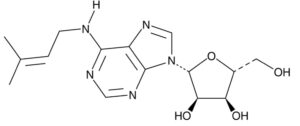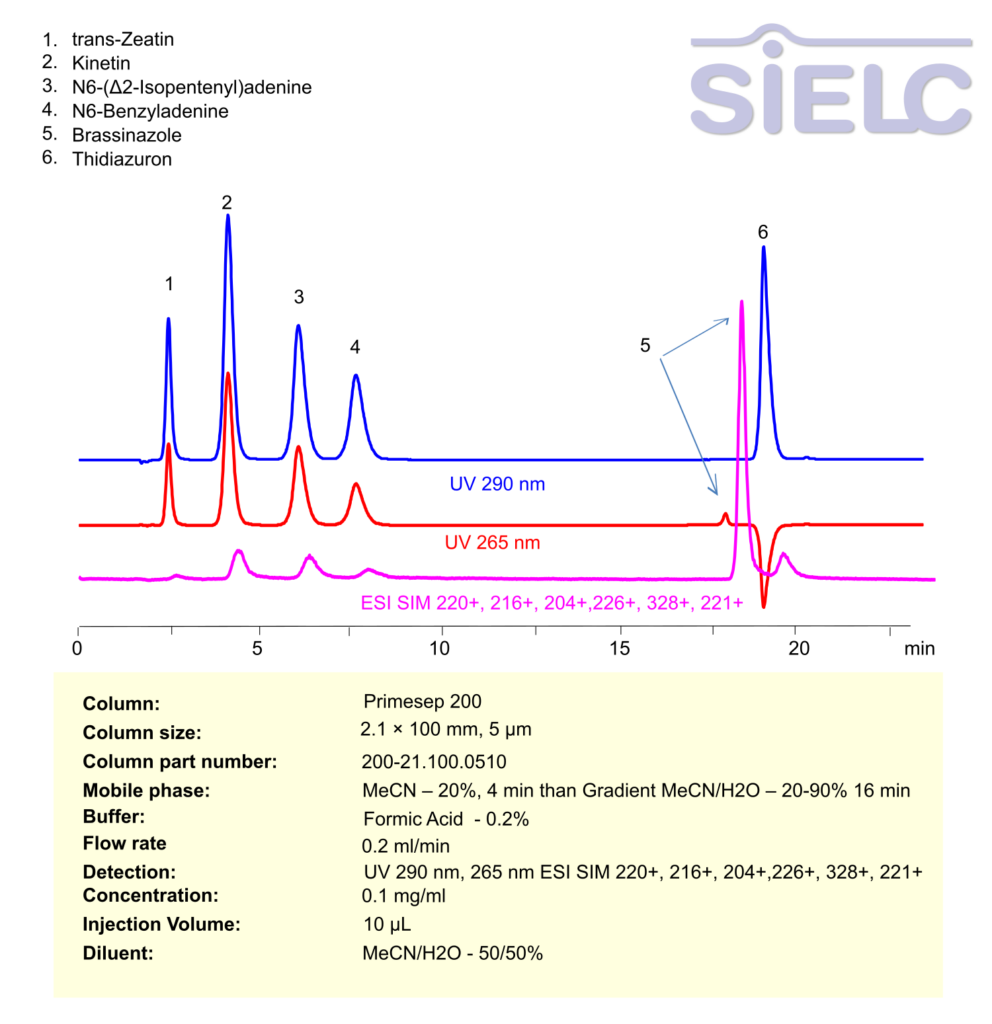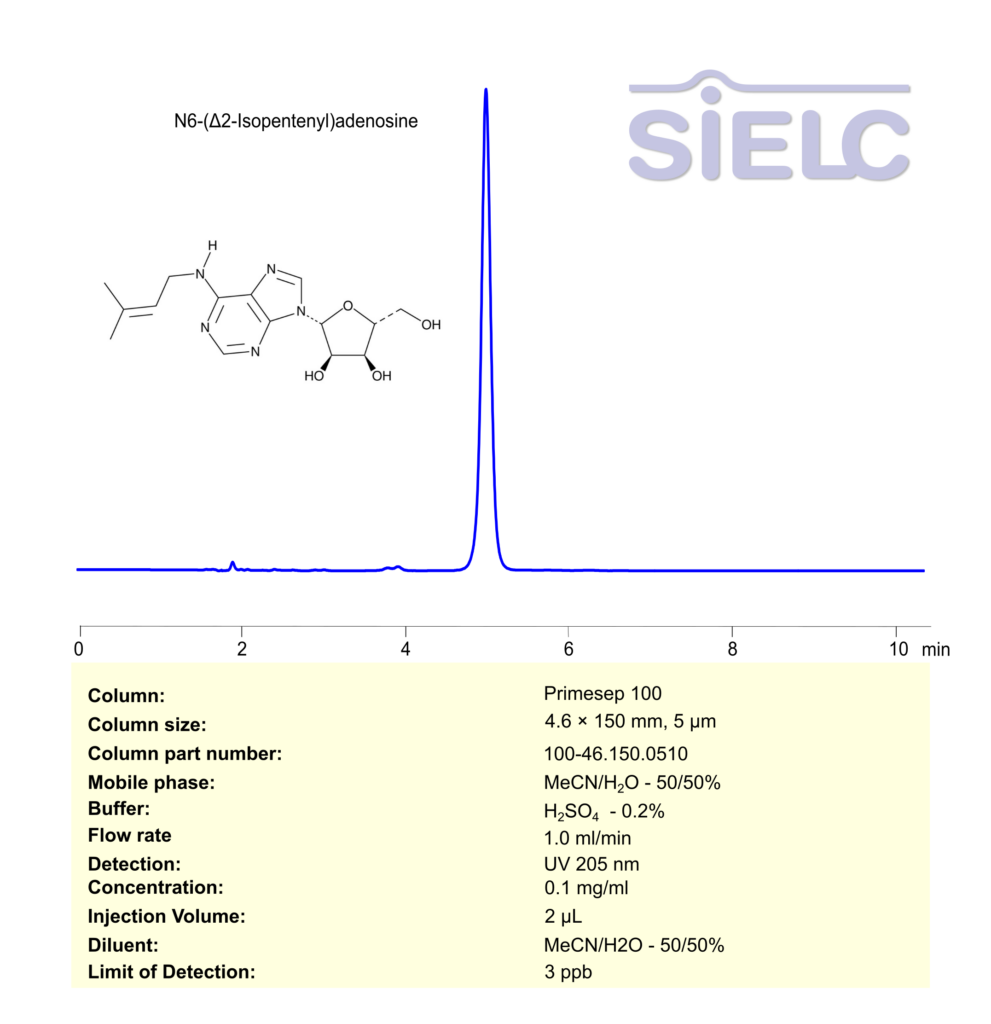
| CAS Number | 7724-76-7 |
|---|---|
| Molecular Formula | C15H21N5O4 |
| Molecular Weight | 335.4 |
| InChI Key | USVMJSALORZVDV-SDBHATRESA-N |
| Synonyms |
|
Applications:
HPLC MS Method for the Analysis of Cytokinins: A Phytohormone Class and Brassinazole on Primesep 200 Column
September 11, 2024
High Performance Liquid Chromatography (HPLC) MS Method for Analysis of trans-Zeatin, Kinetin, N6-(Δ2-Isopentenyl)adenine, Thidiazuron, 6-Benzylaminopurine, Brassinazole on Primesep 200 by SIELC Technologies
Separation type: Liquid Chromatography Mixed-mode SIELC Technologies

High Performance Liquid Chromatography (HPLC) Method for Analysis of trans-Zeatin, Kinetin, N6-(Δ2-Isopentenyl)adenine, Thidiazuron, 6-Benzylaminopurine, Brassinazole
It looks like you’re listing a series of compounds, most of which are cytokinins or related plant hormones. Here’s a brief overview and classification for the compounds you mentioned:
trans-Zeatin:
- A type of cytokinin.
- Naturally occurring in plants and plays a key role in promoting cell division and growth.
Kinetin:
- A synthetic cytokinin.
- Used in plant tissue culture to stimulate cell division.
N6-(Δ2-Isopentenyl)adenine (iP):
- Another cytokinin.
- Found in plants and is involved in regulating growth, development, and differentiation.
N6-Benzyladenine (BA):
- A synthetic cytokinin.
- Commonly used in agricultural practices to enhance plant growth and delay senescence.
Brassinazole:
- Not a cytokinin, but a brassinosteroid biosynthesis inhibitor.
- Used to study the role of brassinosteroids (another class of phytohormones) in plants.
Thidiazuron (TDZ):
- A phenylurea derivative that acts as a cytokinin-like compound.
- Widely used in plant tissue culture to promote shoot regeneration and induce cytokinin-like effects.
trans-Zeatin, Kinetin, N6-(Δ2-Isopentenyl)adenine, Thidiazuron, 6-Benzylaminopurine, Brassinazole can be retained, separated and analyzed using a Primesep 200 mixed-mode stationary phase column. The analysis employs an isocratic method with a simple mobile phase comprising water, acetonitrile (MeCN), and formic acid as a buffer. This method allows for detection using UV 290, 265 nm.
You can find detailed UV spectra of trans-Zeatin, Kinetin, N6-(Δ2-Isopentenyl)adenine, Thidiazuron, 6-Benzylaminopurine, Brassinazole and information about its various lambda maxima by visiting the following link.
| Column | Primesep 200, 2.1 x 100 mm, 5 µm, 100 A, dual ended |
| Mobile Phase | MeCN – 20%, 4 min than Gradient MeCN/H2O – 20-90% 16 min |
| Buffer | Formic Acid -0.2% |
| Flow Rate | 0.2 mg/ml |
| Detection | UV 290 nm, 265 nm ESI SIM 220+, 216+, 204+,226+, 328+, 221+ |
| Class of Compounds | Phytohormone |
| Analyzing Compounds | trans-Zeatin, Kinetin, N6-(Δ2-Isopentenyl)adenine, Thidiazuron, 6-Benzylaminopurine, Brassinazole |
Application Column
Primesep 200
Column Diameter: 2.1 mm
Column Length: 100 mm
Particle Size: 5 µm
Pore Size: 100 A
Column options: dual ended
Brassinazole
Kinetin
N6-(Δ2-Isopentenyl)adenine
Thidiazuron
trans-Zeatin
LC MS Detection

HPLC Method for Analysis of N6-(Δ2-Isopentenyl)adenine on Primesep 100 Column
September 10, 2024
High Performance Liquid Chromatography (HPLC) MS Method for Analysis of N6-(Δ2-Isopentenyl)adenine on Primesep 100 by SIELC Technologies
Separation type: Liquid Chromatography Mixed-mode SIELC Technologies

High Performance Liquid Chromatography (HPLC) Method for Analysis of N6-(Δ2-Isopentenyl)adenine
N6-(Δ²-Isopentenyl)adenine (iP) is a cytokinin, a plant hormone that regulates cell division and growth. Like trans-Zeatin, it is part of the adenine-derived cytokinin family and plays a significant role in promoting plant development and differentiation.
This compound is particularly important in both natural plant physiology and agricultural biotechnology, where it is applied to stimulate growth or improve crop yields.
N6-(Δ2-Isopentenyl)adenine can be retained, separated and analyzed using a Primesep 100 mixed-mode stationary phase column. The analysis employs an isocratic method with a simple mobile phase comprising water, acetonitrile (MeCN), and sulfuric acid as a buffer. This method allows for detection using UV 210 nm.
You can find detailed UV spectra of N6-(Δ2-Isopentenyl)adenine and information about its various lambda maxima by visiting the following link.
| Column | Primesep 100, 4.6 x 150 mm, 5 µm, 100 A, dual ended |
| Mobile Phase | MeCN – 50% |
| Buffer | H2SO4 -0.2% |
| Flow Rate | 1.0 ml/min |
| Detection | UV 205 nm |
| Sample | 0.1 mg/ml |
| Diluent | MeCN/H2O- 50/50% |
| LOD* | 3 ppb |
| Class of Compounds | Phytohormone |
| Analyzing Compounds | N6-(Δ2-Isopentenyl)adenine |
Application Column
Primesep 100
Column Diameter: 4.6 mm
Column Length: 150 mm
Particle Size: 5 µm
Pore Size: 100 A
Column options: dual ended

UV-Vis Spectrum of N6-(Δ2-Isopentenyl)adenine
September 10, 2024
If you are looking for optimized HPLC method to analyze N6-(Δ2-Isopentenyl)adenine check our HPLC Applications library
For optimal results in HPLC analysis, it is recommended to measure absorbance at a wavelength that matches the absorption maximum of the compound(s) being analyzed. The UV spectrum shown can assist in selecting an appropriate wavelength for your analysis. Please note that certain mobile phases and buffers may block wavelengths below 230 nm, rendering absorbance measurement at these wavelengths ineffective. If detection below 230 nm is required, it is recommended to use acetonitrile and water as low UV-transparent mobile phases, with phosphoric acid and its salts, sulfuric acid, and TFA as buffers.
For some compounds, the UV-Vis Spectrum is affected by the pH of the mobile phase. The spectra presented here are measured with an acidic mobile phase that has a pH of 3 or lower.



